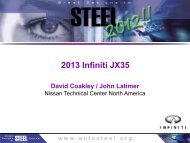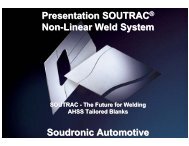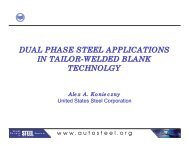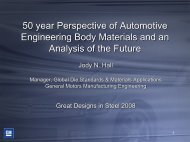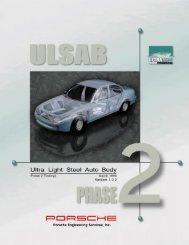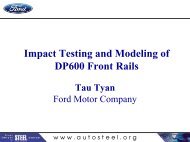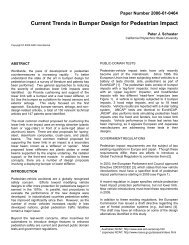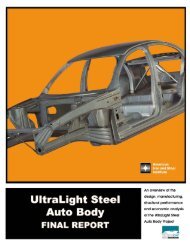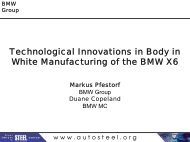Design for Laser Welding - American Iron & Steel Institute
Design for Laser Welding - American Iron & Steel Institute
Design for Laser Welding - American Iron & Steel Institute
Create successful ePaper yourself
Turn your PDF publications into a flip-book with our unique Google optimized e-Paper software.
DESIGN FOR LASER WELDING<br />
David Havrilla<br />
TRUMPF<br />
Manager – Products & Applications<br />
w w w . a u t o s t e e l . o r g
Contents<br />
• Introduction<br />
• Why employ laser welding?<br />
• Fit-up & basic joint configuration<br />
• Joint bridging techniques<br />
• Joint design & feature considerations<br />
• Summary<br />
w w w . a u t o s t e e l . o r g
<strong>Laser</strong> applications - Automotive Industry<br />
Passenger-safety<br />
Chassis/BIW<br />
Engine<br />
Powertrain<br />
Interior<br />
Suspension<br />
w w w . a u t o s t e e l . o r g<br />
Exhaust systems<br />
Electronic<br />
Components
IP Beam<br />
Battery<br />
Engine<br />
Gearbo<br />
x<br />
Torque Converters,<br />
Clutches<br />
Remote<br />
Bumper<br />
<strong>Laser</strong> applications - Automotive Industry<br />
Hot<strong>for</strong>ming<br />
Bumper<br />
A-Pillar<br />
Brazing<br />
Tunnel<br />
Driveshaft<br />
s<br />
Powertrai<br />
n<br />
Cross member<br />
B-Pillar<br />
Roof<br />
Door en<strong>for</strong>cements<br />
w w w . a u t o s t e e l . o r g<br />
Roof rail<br />
Side member<br />
Trunk lid<br />
Rear Center<br />
Component<br />
Side Panel<br />
Doors<br />
Seat Rests,<br />
Tracks,<br />
Recliners<br />
Differentials<br />
Side member
Why employ laser welding?<br />
� Minimum heat input and high aspect ratio resulting in …<br />
> minimal shrinkage & distortion of the workpiece<br />
> small heat affected zone<br />
> narrow weld bead with good appearance<br />
� High strength welds often resulting in …<br />
> improved component stiffness / fatigue strength<br />
> reduction of component size / weight <strong>Design</strong> Optimization<br />
� Ability to weld in areas difficult to reach with other techniques<br />
> non-contact, narrow access, single sided process<br />
� Flexibility …<br />
> beam manipulation (beam switching and sharing)<br />
> variety of part & weld geometries and materials<br />
w w w . a u t o s t e e l . o r g
Why employ laser welding?<br />
� Cost savings ...<br />
> high productivity >> faster cycle time = less stations & less floor space<br />
> reduction of manual labor, scrap & re-work<br />
> reduction of component material and weight<br />
> can eliminate secondary processes<br />
<strong>Laser</strong> <strong>Welding</strong> vs. Resistance Spot <strong>Welding</strong><br />
� Reduction or elimination of flanges<br />
> reduction of component size / weight<br />
> reduced cost<br />
> greater visibility / accessibility<br />
� Increased strength / stiffness<br />
> localized increase of component strength / stiffness / fatigue strength<br />
> weld shape optimization <strong>for</strong> component loading / stresses<br />
> elimination of lower electrode access holes<br />
w w w . a u t o s t e e l . o r g
Access<br />
Quality<br />
Cost<br />
Visibility<br />
Drivers - Automotive Industry<br />
Stiffness<br />
Process Stability<br />
Body designed <strong>for</strong><br />
laser manufacturing<br />
w w w . a u t o s t e e l . o r g<br />
Floor space<br />
Maintenance<br />
Throughput<br />
Weight
<strong>Laser</strong> – The Universal Tool <strong>for</strong> <strong>Welding</strong><br />
<strong>Laser</strong> welding<br />
HF<br />
TIG<br />
EB<br />
Plasma<br />
MIG<br />
• Narrow weld seam<br />
• Min. heat affected zone<br />
• Little metallurgic effects<br />
on the material<br />
EB<br />
Seam welding<br />
Spot welding<br />
w w w . a u t o s t e e l . o r g<br />
MIG<br />
TIG TIG<br />
EB<br />
• Little distortion<br />
MIG<br />
• No filler material required<br />
• High process speed<br />
• Non-contact<br />
• No wear
<strong>Laser</strong> as a tool<br />
• relatively wide / narrow<br />
• continuous / stitch / spot<br />
• through / partial<br />
• line / optimized shape<br />
• conventional / remote<br />
• multiple layers<br />
w w w . a u t o s t e e l . o r g<br />
When would you want wide? When<br />
narrow?<br />
What benefits does partial<br />
penetration have?<br />
Why would you want a shape that<br />
is not a straight line?
Material selection<br />
1. Causes of porosity, underfill, undercut:<br />
� Volatile constituents (e.g. S, P)<br />
� Volatile coatings/surface contaminants (e.g. Zn, oil based lubricants)<br />
Notes <strong>for</strong> welding of Zn coated steels in overlap configuration<br />
a. Increased weld length may compensate <strong>for</strong> porosity in non-critical components<br />
b. Electro-galvanized & electro-galvaneal are better than hot dipped galvanized<br />
c. Bare to Zn is often okay (especially electro plated)<br />
d. Zn to Zn configurations usually require a gap and/or Zn exhaust path <strong>for</strong><br />
reasonable results (e.g. dimples, shims, knurling, fixture/tooling, leading<br />
pressure finger, part design, joint design)<br />
e. Watch out <strong>for</strong> patent infringements!<br />
w w w . a u t o s t e e l . o r g
Material selection<br />
2. Brittleness & cracking:<br />
� Can occur in steels when >0.3%C<br />
(>0.4%C equivalent)<br />
� 6000 series aluminum<br />
3. Reflectivity<br />
With high reflective materials (e.g.<br />
Al, Cu) – 1 micron wavelength has<br />
greater absorption than 10.6<br />
microns<br />
w w w . a u t o s t e e l . o r g
Seam and joint types<br />
Lap weld on lap joint Seam weld on butt joint<br />
w w w . a u t o s t e e l . o r g
Name<br />
Seam and joint types<br />
Seam weld on butt joint<br />
Lap weld on lap joint<br />
Example Characteristics<br />
w w w . a u t o s t e e l . o r g<br />
Think about a positive & negative<br />
characteristic of both the butt & lap weld<br />
configurations.<br />
+ Weld Fusion Area<br />
• less material = weight & cost<br />
savings<br />
• faster or less power<br />
• less HAZ / distortion<br />
• no issues w/ Zn<br />
• no step<br />
- Positioning Tolerance<br />
• edge requirements<br />
• fit up can be more difficult to obtain<br />
+ Positioning Tolerance<br />
• larger process window<br />
• can have aesthetic underside<br />
- Weld Fusion Area<br />
• more energy required = slower or<br />
higher power & more distortion / HAZ<br />
• inefficient process
Name<br />
Seam and joint types<br />
Seam weld on stepped lap joint<br />
Seam weld on T-joint<br />
Example Characteristics<br />
w w w . a u t o s t e e l . o r g<br />
+ weld fusion area<br />
- positioning tolerance<br />
+ weld fusion area<br />
- positioning tolerance
Name<br />
Seam and joint types<br />
Lap weld on T / border joint<br />
Seam weld on flange<br />
Lap weld on <strong>for</strong>med seam<br />
Example Characteristics<br />
w w w . a u t o s t e e l . o r g<br />
+ positioning tolerance<br />
- weld fusion area<br />
+ weld fusion area<br />
- positioning tolerance<br />
+ positioning tolerance<br />
- weld fusion area
Fit-up requirements<br />
Butt joint configuration:<br />
� Gap: 3-10% thickness of thinnest sheet<br />
� Offset: 5-12% thickness of thinnest sheet<br />
Overlap joint configuration:<br />
� Gap: 5-10% thickness of top sheet<br />
Why is this general guideline not absolute?<br />
(What influences the amount of gap that can be bridged?)<br />
� Focus spot size<br />
� Edge geometry <strong>for</strong> butt weld<br />
� Strength requirements<br />
w w w . a u t o s t e e l . o r g
The importance of good fit-up<br />
• For autogenous laser welding, weld strength is a function of weld joint<br />
fit-up.<br />
• A gap (or mismatch) reduces weld strength because it can yield an<br />
underfill and/or undercut which …<br />
a. Reduces weld area (S = F/A)<br />
b. Creates a stress riser<br />
F<br />
w w w . a u t o s t e e l . o r g<br />
Stress concentration<br />
Lines of <strong>for</strong>ce<br />
F
Tolerance compensation<br />
Toler. compensat.<br />
w w w . a u t o s t e e l . o r g<br />
Toler. compensat.
Tolerance compensation<br />
Toler. compensat.<br />
Toler. compensat.<br />
w w w . a u t o s t e e l . o r g<br />
Toler. compensat.<br />
Toler. compensat.
Autogenous<br />
� Larger focus spot<br />
� Twin spot<br />
Non-autogenous<br />
� Hybrid (laser + MIG + wire feed)<br />
� Wire feed<br />
Joint bridging techniques<br />
- slower, more heat input<br />
+ 2x higher power density<br />
+ Less wasted energy<br />
= faster !!<br />
- Directionality<br />
- cost, complexity, may<br />
require vision system<br />
+ gap & metallurgical<br />
bridging<br />
w w w . a u t o s t e e l . o r g
<strong>Design</strong> features<br />
w w w . a u t o s t e e l . o r g<br />
View turned by 180 degree<br />
F<br />
1 x s<br />
Patent pending
<strong>Design</strong> features<br />
Material fit of a K-Joint<br />
w w w . a u t o s t e e l . o r g<br />
Patent pending
<strong>Design</strong> features<br />
Weld Seam on a K-Joint<br />
w w w . a u t o s t e e l . o r g<br />
Patent pending
<strong>Design</strong> features<br />
Different Applications of a K-Joint<br />
w w w . a u t o s t e e l . o r g<br />
Patent pending
<strong>Design</strong> features<br />
K- Joint in Application / Flange-reduced <strong>Design</strong><br />
w w w . a u t o s t e e l . o r g
<strong>Design</strong> features<br />
Specialized cutting & bending of tubes<br />
Multiple bend tubes:<br />
Allows 3 dimensional structures.<br />
w w w . a u t o s t e e l . o r g<br />
Bend tubes:<br />
Allows high quality on corners.
<strong>Design</strong> features<br />
Specialized cutting & bending of tubes w/ positioning aids<br />
Special bent tubes<br />
techniques create<br />
connections with the<br />
need of only a few<br />
welds.<br />
Positioning aids<br />
w w w . a u t o s t e e l . o r g
<strong>Design</strong> features<br />
Positioning tabs & bayonets <strong>for</strong> tubes<br />
Perfect interface <strong>for</strong><br />
welding operations<br />
Precision location<br />
w w w . a u t o s t e e l . o r g<br />
Bayonet coupling ensures<br />
orientation and reduces<br />
need <strong>for</strong> precision fixturing.
<strong>Design</strong> features<br />
More Tube Interfaces<br />
w w w . a u t o s t e e l . o r g<br />
– Coding system<br />
to avoid possible assembly<br />
mistakes,<br />
accurate position.
<strong>Design</strong> features<br />
Positioning tabs <strong>for</strong> tubes & plates<br />
Mounting plate to tube:<br />
Well suited <strong>for</strong> welding<br />
High positioning accuracy<br />
w w w . a u t o s t e e l . o r g<br />
Accurate sheet flange to tube design
<strong>Design</strong> features<br />
Interlocking tabs <strong>for</strong> tubes<br />
w w w . a u t o s t e e l . o r g
<strong>Design</strong> features<br />
Integrating locating & interlocking features<br />
w w w . a u t o s t e e l . o r g
Tunnel<br />
<strong>Design</strong> features<br />
Concept <strong>for</strong> an Underbody design<br />
with K-Joint & Interlocked Joints<br />
Interlocked Joints<br />
w w w . a u t o s t e e l . o r g<br />
Cross Member<br />
(Seat)<br />
K- Joint<br />
Integrated Longitudinal<br />
En<strong>for</strong>cement
Tolerance Compensation<br />
K-Joint & Interlocked <strong>Design</strong> <strong>for</strong> Underbody<br />
w w w . a u t o s t e e l . o r g
<strong>Design</strong> <strong>for</strong> laser welding summary (pt. 1)<br />
� <strong>Design</strong> & re-design components <strong>for</strong> laser welding<br />
� Reduce component weight & cost by reducing or eliminating<br />
flange widths (enabled by single sided, narrow beam access)<br />
� Increase vehicle accessibility & driver visibility by reducing or<br />
eliminating flange widths (enabled by single sided, narrow beam<br />
access)<br />
� Reduce component weight and cost by reducing gage thickness<br />
(enabled by increasing strength through optimized weld shapes<br />
and/or continuous weld seams in high stress locations)<br />
� Reduce component weight and cost, and increase strength<br />
(enabled by elimination of RSW lower electrode access holes in<br />
structural rein<strong>for</strong>cements)<br />
w w w . a u t o s t e e l . o r g
<strong>Design</strong> <strong>for</strong> laser welding summary (pt. 2)<br />
� Know & employ the strengths of the full variety of weld joint<br />
styles<br />
� Realize there are several ways to bridge the gap, … but don’t<br />
start there<br />
� Consider the variety of design features when designing <strong>for</strong> laser<br />
welding (e.g. K-Joint, positioning aids, tabs, bayonets, interlocking joints,<br />
tolerance compensation planes, etc.)<br />
w w w . a u t o s t e e l . o r g
Continuous Education / Improvement<br />
<strong>Laser</strong> <strong>Welding</strong><br />
Christopher Dawes<br />
Abington Publishing (1992)<br />
<strong>Laser</strong> <strong>Welding</strong><br />
Walter W. Duley<br />
John Wiley & Sons (1999)<br />
<strong>Laser</strong> Material Processing – Fourth Edition<br />
William M. Steen / Jyoti Mazumder<br />
Springer (2010)<br />
AWS <strong>Welding</strong> Handbook<br />
<strong>Welding</strong> Processes, Part 2<br />
Ninth Edition, Volume 3<br />
<strong>American</strong> <strong>Welding</strong> Society (2007)<br />
LIA Handbook of <strong>Laser</strong> Material Processing<br />
John F. Ready – Editor in Chief<br />
<strong>Laser</strong> <strong>Institute</strong> of America (2001)<br />
w w w . a u t o s t e e l . o r g
Please Join Us!<br />
Thursday, May 17 th<br />
5:30 – 9:00 PM<br />
5:30-6:00 Registration<br />
TRUMPF Open House – Tomorrow Evening<br />
6:00-6:20 Keynote address by Gary<br />
Vasilash<br />
6:30-9:00 Machine Demonstrations<br />
w w w . a u t o s t e e l . o r g
Thank you<br />
w w w . a u t o s t e e l . o r g<br />
TRUMPF <strong>Laser</strong> Technology Center<br />
Plymouth, MI<br />
(734) 454-7200
<strong>Design</strong> optimization<br />
<strong>Laser</strong> welding<br />
Resistance spot welding <strong>Laser</strong> welding<br />
• Flange Reduction or Elimination (flangeless design)<br />
• Better Accessibility<br />
• Less Interference<br />
w w w . a u t o s t e e l . o r g<br />
F<br />
F
Principle of time sharing<br />
� Throughput maximization & manufacturing flexibility<br />
w w w . a u t o s t e e l . o r g
Principle of energy sharing<br />
� Reduced distortion<br />
Distortion<br />
w w w . a u t o s t e e l . o r g
Continuous weld & strength optimization<br />
w w w . a u t o s t e e l . o r g
Advantage: Programmable Weld Shapes<br />
Customized weld patterns <strong>for</strong> optimal joint strength:<br />
� Distribution<br />
� Orientation<br />
� Shape<br />
w w w . a u t o s t e e l . o r g
Elimination of lower electrode<br />
w w w . a u t o s t e e l . o r g
Summary: Golf IV / Golf V<br />
Goals reached:<br />
- Increased process speed (joining)<br />
- Increased productivity<br />
- Increased strength compared to alternative joining methods<br />
- Reduced heat distortion<br />
- Narrow or no flange => Weight reduction<br />
- High flexibility via sharing & back-up of lasers into different work cells<br />
- Reduced floor space<br />
Golf IV Golf V<br />
Floor space Side panel 2816 m 2 1472 m 2 (-50%)<br />
Floor space Underbody 480 m 2 320 m 2 (-33%)<br />
# of Weld spots 4608 1400<br />
Length of laser weld 1.4 m 70 m<br />
w w w . a u t o s t e e l . o r g
Wide vs. narrow<br />
Wide<br />
Overlap welding<br />
Poor edges<br />
Poor fit-up<br />
Poor beam to seam<br />
location tolerance<br />
Narrow<br />
w w w . a u t o s t e e l . o r g<br />
Low distortion, high<br />
speed welding w/<br />
minimum power <strong>for</strong><br />
butt welding<br />
configurations<br />
… but, good edges,<br />
excellent fit-up, & good<br />
beam to seam location<br />
tolerance required
Partial penetration vs. full penetration<br />
Partial<br />
Compared to through penetration weld …<br />
• Aesthetics on back side of component<br />
• Mating part considerations (fit-up & friction)<br />
• Thickness of lower part (through penetration<br />
may be impractical or impossible)<br />
• Protection of heat or spatter sensitive<br />
components<br />
• Higher speeds (or lower laser power) w/ less<br />
HAZ & distortion<br />
w w w . a u t o s t e e l . o r g<br />
Full<br />
Compared to partial penetration weld …<br />
• Visual weld verification possible<br />
• Larger fusion area <strong>for</strong> butt weld configuration
F<br />
Advantage: Programmable Weld Shapes<br />
F F<br />
w w w . a u t o s t e e l . o r g<br />
F<br />
Stress = F / A
Advantage: Programmable Weld Shapes<br />
Peel<br />
Peel<br />
w w w . a u t o s t e e l . o r g
Zn coated material: Gap <strong>for</strong> out gassing<br />
� Evaporating temperature of zinc < melting temperature of steel<br />
� Vapor pressure causes expulsion of molten steel in upper sheet<br />
� Result: <strong>Welding</strong> seam becomes highly porous and weak<br />
Zero Gap<br />
w w w . a u t o s t e e l . o r g
Gap <strong>for</strong> out gassing: <strong>Laser</strong> dimpling<br />
� Pre-treatment of one sheet to generate 0.1-0.2mm standoff between sheets<br />
� Use of same laser equipment and optics<br />
0.2 mm Gap<br />
w w w . a u t o s t e e l . o r g
Gap <strong>for</strong> out gassing: <strong>Laser</strong> dimpling<br />
� Constant dimple height (depending on zinc layer approximately 0.15 mm)<br />
� Dimple height adjustable via laser parameter<br />
w w w . a u t o s t e e l . o r g
� Step 1:<br />
Gap <strong>for</strong> out gassing: <strong>Laser</strong> dimpling<br />
<strong>Laser</strong> Dimpling<br />
� Step 2:<br />
Placement of<br />
upper sheet<br />
BEO<br />
Feed rate or<br />
PFO<br />
Feed rate<br />
w w w . a u t o s t e e l . o r g<br />
� Step 3:<br />
Scanner <strong>Welding</strong><br />
BEO<br />
or<br />
PFO



